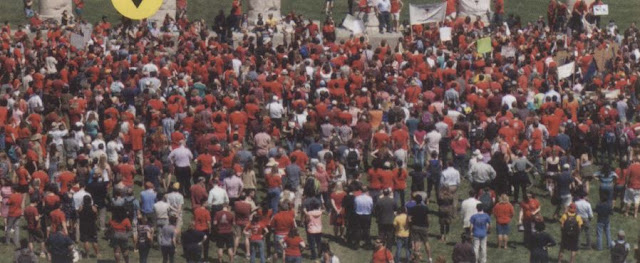Student Activism at MU: Voices of Change
Demonstrating for Peace
 | |||
| In 1940 MU students marched for peace (Savitar 1994). |
 |
|
“Gentle Saturday,” a demonstration for peace in 1968 (Savitar 1968).
|
Anti-War Protests
 |
|
Students protest the Vietnam War (Savitar 1970).
|
 |
| Students for Progressive Action staged a protest against the Iraq War at the Boone County Courthouse in 2002 (Savitar 2002). |
Advocating for Better Treatment of Minorities and Women at the University
 |
|
Members of Delta Gamma show their support for women’s
liberation in 1972 (Savitar 1994).
|
 |
|
In 1989 students protested the fact that the
University of Missouri did not honor Martin Luther King Jr. Day (Missouri Alumnus Fall 1993).
|
 |
|
During Homecoming, 200 students from the Legion of
Black Collegians staged a peaceful protest to call attention to insensitivity towards
minorities at the university (Savitar 1991).
|
 |
In the wake of the Rodney King verdict in 1992
students joined protests in Columbia numbering 900 strong (Savitar 1992).
|
 |
|
The National Pan Hellenic Council organized a sit in at
Jesse Hall. This was in reaction to an
article written in the MU Student News by a student of the Zeta Tau Alpha
Sorority accusing black sorority members of tearing down philanthropy banners
in Greek Town (Savitar 2003).
|
 |
|
The 2015 movement “Concerned Student 1950” is in
reference to the year that black students were first admitted to the
University. Several instances of racism
on campus sparked a series of protests in the fall of 2015. A Homecoming Parade face-off between student
protesters and MU System President Tim Wolfe heated up events. Graduate student Jonathan Butler began a
hunger strike in response to Wolfe’s reaction to racism on campus and the
treatment of graduate students when their health insurance was suddenly
revoked. Students camped out on the Quad in support of Butler. Eventually both UM System President Tim Wolfe and MU Chancellor R. Bowen Loftin resigned from their posts (MIZZOU Spring 2016).
|
Advocating for Campus Issues
 |
|
In 1968 Professor William Allen organized a chalk-in
where 1,500 students gathered to protest three students who were arrested and
sentenced 45 days in jail for writing peace slogans in chalk on the sidewalk (Savitar 1994).
|
 |
|
Students, faculty, and administration worked
together to change the rules of intervisitation at the university so that
guests of the opposite sexes could be allowed in student rooms between 12-5 pm
any Saturday or Sunday and from 8-11 pm on Friday and Saturday nights. However, the Board of Curators shot down this
proposal. Students protested with a sleep-in at Memorial Union (Savitar 1969).
|
 |
|
Rallies began in 1970 against the War in Cambodia, the
Kent State Massacre, and Vietnam, but by the end of May it had boiled down to a
clash between students and administration. Chancellor John Schwada
warned students that those who took part in such demonstrations were liable to
discipline by the University. Thousands of students gathered in front of
the Chancellor’s residence to protests and Dr. Bill Wickersham, pictured above, delivered students’ demands of the chancellor: they
wanted him to make a statement explaining his position on the Vietnam War and
Kent State. Dean Jack Matthews delivered a
statement from the Chancellor demanding that students disperse. They did not
and campus police was called in and students were arrested. Eventually students and the administration got
together and agreed on a resolution that left it up to professors whether
students could be released from courses to work for peace (Savitar 1970).
|
 |
|
Throughout the late 1980s students protested
against University’s investment in companies that supported apartheid South
Africa. The issue quickly escalated to
become also about freedom to protest on campus. In protest to the University’s unwillingness
to fully divest, students erected wooden shanties on the Quad, which became
known as “Shantytown.” The University responded
by removing students and the shanties, via campus police, and students in turn
rebuilt their shanties and continued protest. In 1988 the Board of Curators
voted to fully divest in these holdings (Missouri Alumnus Fall 1994).
|
 |
|
Hundreds of graduate students and faculty members protested throughout the 2015-2016 academic school year. Resistance began after the University revoked insurance subsidies from the graduate students with only 12 hours notice. Graduate students then began a fight to unionize that is currently tied up in the courts (MIZZOU Spring 2016).
Blogpost authored by Lauren DiSalvo, Curator of Public Arts at the University of Missouri Student Unions
|



